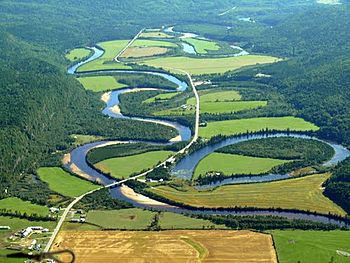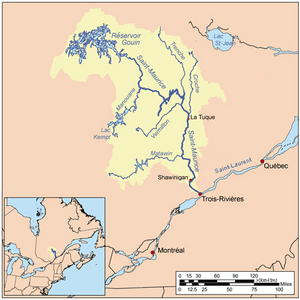Croche River (La Tuque) facts for kids
Quick facts for kids Croche River |
|
|---|---|

Rivière Croche
|
|

"Rivière Croche" (Croche River) is very serpentine in some segments.
|
|
| Native name | Rivière Croche |
| Country | |
| Province | |
| Region | Saguenay-Lac-Saint-Jean and Mauricie |
| Regional County Municipality | Le Domaine-du-Roy Regional County Municipality and La Tuque |
| Physical characteristics | |
| Main source | Lac du Caribou Lac-Ashuapmushuan 435 m (1,427 ft) 48°24′18″N 72°43′44″W / 48.40500°N 72.72889°W |
| River mouth | Saint-Maurice River Canton de Malhiot in La Tuque (hamlet Rivière-Croche) 151 m (495 ft) 47°29′40″N 72°46′29″W / 47.49444°N 72.77472°W |
| Length | 160.7 km (99.9 mi) |
| Basin features | |
| River system | St. Lawrence River |
| Basin size | Saint-Maurice River |
| Tributaries |
|
The Croche River is a river in Quebec, Canada. It flows through the Saguenay-Lac-Saint-Jean and Mauricie regions. This river is a tributary, which means it flows into a larger river, the Saint-Maurice River. The Croche River is actually one of the five biggest rivers that feed into the Saint-Maurice River.
Contents
Journey of the Croche River
The Croche River starts its journey at Caribou Lake. This lake is about 100 kilometers (62 miles) north of La Tuque. From there, the river flows south through a narrow valley. Along its path, it forms many lakes and takes lots of twists and turns. These bends are actually how the river got its name!
The river is 160.7 kilometers (about 100 miles) long. As it flows, it drops about 284 meters (932 feet) in height. Many smaller streams join the Croche River, especially in its northern part. You'll find many rapids, waterfalls, and cascades along its route.
The river's path can be divided into three main parts:
River's Start
The river begins at Caribou Lake. It flows east, then southeast, passing through several smaller lakes like Lac aux Rats and Lac du Cygne. It also goes through marshy areas and under forest road bridges. This part of the river is known for its many bends and turns.
Middle Part of the River
After Lac Panache, the river continues southwest. It collects water from other streams, like the Goélands stream. It also flows through Lac Davenne. In this section, the river has several falls and rapids. It then meets the Patrick River and the rivière du Brûlé (Croche River).
River's End
In its final section, the Croche River flows south. It passes under more forest road bridges and goes through rapids and falls. It also meets the Petite rivière Croche. The river continues to wind and turn a lot in this part. It passes under railway and road bridges before finally joining the Saint-Maurice River. This meeting point is about 5 kilometers (3 miles) north of La Tuque.
The last 20 kilometers (12 miles) of the river flow through a rich farming area.
River's Past
A long time ago, the area around the lower part of the Croche River was covered in thick forests. These forests had many deciduous trees, which are trees that lose their leaves in the fall. This was because the soil near the river was very rich and good for growing things.
In the late 1800s and early 1900s, people started clearing the forests to create farms. Many farms were set up along the river. Even though the river wasn't very deep, it was used to float logs. These logs were sent to sawmills and paper factories in La Tuque and further down the Saint-Maurice River.
There was a famous farm called "ferme de la Croche" (La Croche Farm). It was probably built by a family called the Halls. Over time, different logging companies owned the farm. A famous explorer named Bishop Caron wrote in 1887 that the Halls were renting this farm. But around 1890, the farm was likely abandoned, and people even said it was "haunted"!
Why the Name "Croche"?
The name "Croche River" became official on December 5, 1968. "Croche" is a French word that means "crooked" or "bent." This name perfectly describes the river because it has so many twists, turns, and bends, especially in its lower parts.
Many places in Quebec have the word "Croche" in their names, including 102 lakes! Because so many rivers were called "Croche," some of them were given new, more unique names. These new names often described something special about the place or were named after people or Indigenous words.
Today, there are still five "Croche Rivers" in Quebec, plus a "Petite rivière Croche" (Small Croche River) and a "rivière crochue" (Crooked River). The word "Croche" is also part of the names of three towns in Quebec: Lac-Croche, Quebec, La Croche, and the hamlet of "Rivière Croche" in Mauricie.

